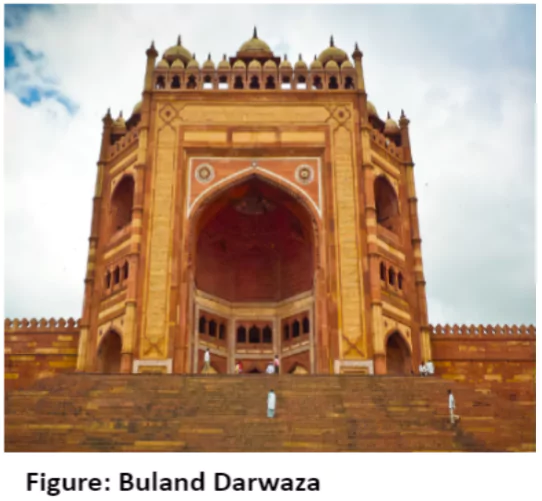Under Akbar’s rule, art and architecture flourished, reflecting a blend of indigenous and foreign influences. From majestic forts to religious tolerance, Akbar’s era witnessed remarkable developments in various artistic endeavors, including literature, calligraphy, painting, and music.
An Overview of Akbar’s Reign: A Flourishing Era of Art, Architecture and Tolerance
1. Architecture

- Forts: Agra Fort was constructed using red sandstone. Additional forts were erected in Lahore and Allahabad.
- Inside Agra Fort, Akbar built the Jahangiri Mahal, incorporating Hindu design principles inspired by the Man Mandir.
- Fatehpur Sikri (The City of Victory): It is a UNESCO World Heritage Site. It includes:
- Buland Darwaza (built after the victory over Gujarat in 1572), Jama Masjid, Jodha Bai’s palace, the Panch Mahal designed akin to a Buddhist Vihara, the Diwan-i-Khas, the Diwan-i-Aam, and Sheikh Salim Chisti’s tomb.
Enroll now for UPSC Online Course
2. Religious Views
- Reformative steps: Stopped the forcible conversion of prisoners of war.
- Abolished the tax on pilgrimage in 1563 and jizya in 1564.
- The practise of sati by force was outlawed; allowed widow remarriage, and
- Permitted Hindus to repair and build new temples.
- Construction of Ibadat Khana (Hall of Prayers) at Fatehpur Sikri
- Scholars from various religions including Hinduism, Jainism, Christianity, and Zoroastrianism were welcomed for religious discussions.
- The scholars at Ibadat Khana included Pursottam Das, Hira Vijaya Suri, Dastur Maharji Rana, Monserrate, and Acquaviva.
- Din-i-Ilahi : Akbar introduced a new religion called Din-i-Ilahi or Tauhind-i-Ilahi (Divine Monotheism) in 1582.
- Limited Adherents: It emphasised belief in one God and “Sulh-i-Kul” incorporating positive aspects from various religions with a rational foundation as documented by Badayuni. Despite efforts, Din-i-Ilahi did not gain widespread acceptance and gradually faded after Akbar’s demise.
- During Akbar’s lifetime, only a few individuals including Birbal, Abul Fazl, and Abul Faizi followed this new faith.
- Honouring Diversity: Jain monk Hari Vijay Suri visited and stayed for a few years in Akbar’s court and was honoured with the title of Jagadguru.
- Sulh-i-Kul (Universal Peace): Abu’l Fazl describes the ideal of Sulh-i-Kul as the cornerstone of enlightened rule through religious tolerance and inclusivity.
- In Sulh-i-kul, all religions and schools of thought had freedom of expression but on the condition that they did not undermine the authority of the state or fight among themselves.
3. Literature
- Akbar Nama: was compiled by Abul Fazl. It contained three volumes of the history of Akbar’s reign.
- 1st volume dealt with Akbar’s ancestors.
- 2nd volume recorded the events of Akbar’s reign.
- 3rd volume was the Ain-i-Akbari.
- Ain-i-Akbari: deals with Akbar’s administration, army, revenues, and geography of his empire.
- Details about the traditions and culture of the people living in India.
- Statistical details about crops, yields, prices, and wages.
- Kitab Khana: was a library, i.e., a place where the emperor’s collection of manuscripts was kept and new manuscripts were produced.
- Translations
- Mahabharata: renamed ‘Razmnama’ (Book of Wars) was translated into Persian. It was completed in 1589 under the supervision of master artist Daswant.
- Leelavati: by Bhaskaracharya was translated by Faizi into Persian.
- Akbar Nama: was translated into English by Henry Beveridge in the early twentieth century.
- Maktab Khana: Akbar maintained a Maktab khana (‘house of translations’) in Fatehpur Sikri in 1574.
- Its primary intention was inter-religious cooperation.
- Calligraphy: the art of handwriting, gained prominence.
- Muhammad Husayn al-Katib Kashmiri (c. 1575-1605), was the most celebrated calligrapher at the court of the emperor Akbar, who gave him the title of Zarrin Qalam (Golden Pen).
- He continued to work at the court of Jahangir and his recorded work is dated between (1580-1608 AD).
- Akbar’s favourite was the Nastaliq
4. Paintings
- Prominent painters: Daswant and Basawan.
- Madonna and Child (1580) by Baswan is an important work of the Mughal School of Painting.
- Akbar Hamzanama (best known for the enormous illustrated manuscript)
- This magnificent project was completed under the supervision of two Persian masters — Mir Sayyid Ali and Abd us Samad.
5. Akbar’s Navratanas
- Akbar’s court was said to have a group of intellectuals known as the Navaratnas.
Enroll now for UPSC Online Classes
| Abul Fazl |
- Royal court historian Akbar Nama.
|
| Faizi (Raj Kavi) |
- Persian poet and elder brother of Abul Fazl
|
| Fakir Aziao Din |
- A Sufi mystic and a key advisor to Akbar.
|
| Tansen (Ramatanu Pandey) |
- Renowned musician, a court musician to King Ramachandra, who accepted Islam under Sufi mystic Muhammad Ghaus of Gwalior. Tansen was the title given to him by Raja Vikramjit of Gwalior [UPSC-2019].
- Akbar bestowed upon him the name “Mian.”
|
| Birbal (Kavi Priya) |
- A courtier bestowed with the titles Raja and Birbal by Akbar.
- Died fighting Yusuf Shahis on the Northwest frontiers
|
| Raja Todar Mal
(Title: Diwan-i-Ashraf) |
- Finance minister overseeing the revenue system.
- Introduced standard weights, measurements, and revenue districts.
|
| Raja Man Singh |
- A Mansabdar, the grandson of Akbar’s father-in-law.
|
| Abdul Rahim Khan-i-Khanan |
- A great poet; translated Babarnama into Turki, Son of Bairam Khan.
|
| Mulla Do-Piyaza |
- Advisor and Wazir of the Mughal emperor Akbar.
|
Conclusion
Akbar’s patronage of art and culture left an indelible mark on Indian history, fostering an environment of creativity and intellectual exchange. Through his inclusive policies and support for diverse forms of expression, Akbar created a legacy that continues to inspire admiration and study today.
![]() May 15, 2024
May 15, 2024
![]() 4915
4915
![]() 0
0
